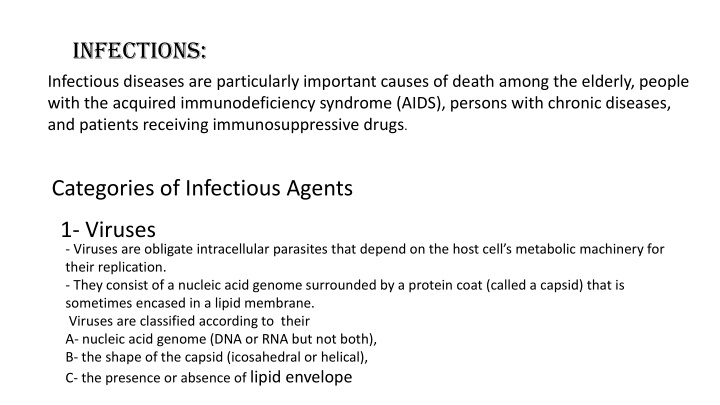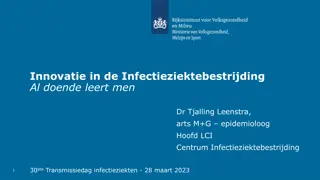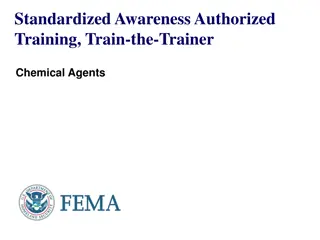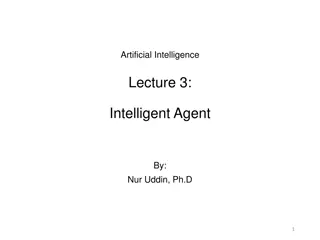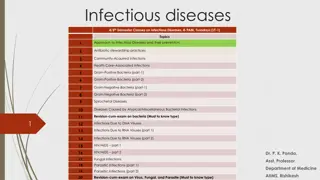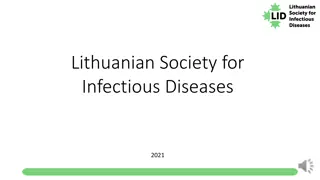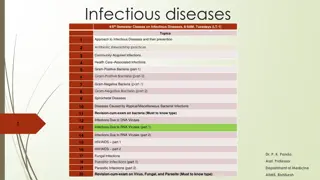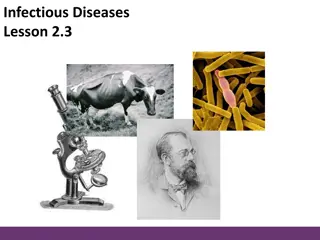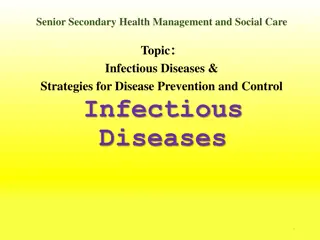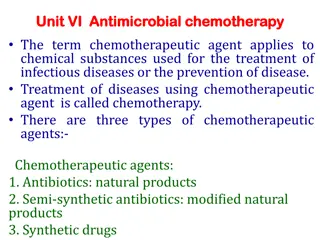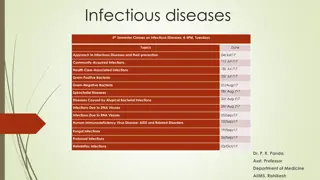Infectious Agents and Their Impact
Infectious diseases are significant causes of mortality in vulnerable populations due to infections caused by viruses and bacteria. Viruses are intracellular parasites with diverse genomic and capsid structures, leading to transient or chronic illnesses. Bacteria exhibit varied cell wall structures and shapes, categorized by Gram staining, shape, and oxygen requirement, influencing their pathogenicity. Understanding the classification and characteristics of infectious agents is crucial for effective disease management.
Download Presentation

Please find below an Image/Link to download the presentation.
The content on the website is provided AS IS for your information and personal use only. It may not be sold, licensed, or shared on other websites without obtaining consent from the author.If you encounter any issues during the download, it is possible that the publisher has removed the file from their server.
You are allowed to download the files provided on this website for personal or commercial use, subject to the condition that they are used lawfully. All files are the property of their respective owners.
The content on the website is provided AS IS for your information and personal use only. It may not be sold, licensed, or shared on other websites without obtaining consent from the author.
E N D
Presentation Transcript
Infections: Infectious diseases are particularly important causes of death among the elderly, people with the acquired immunodeficiency syndrome (AIDS), persons with chronic diseases, and patients receiving immunosuppressive drugs. Categories of Infectious Agents 1- Viruses - Viruses are obligate intracellular parasites that depend on the host cell s metabolic machinery for their replication. - They consist of a nucleic acid genome surrounded by a protein coat (called a capsid) that is sometimes encased in a lipid membrane. Viruses are classified according to their A- nucleic acid genome (DNA or RNA but not both), B- the shape of the capsid (icosahedral or helical), C- the presence or absence of lipid envelope
icosahedral helical virus
Many viruses cause transient illnesses (e.g., colds, influenza). Other viruses are not eliminated from the body and persist within cells of the host for years, either continuing to multiply (e.g., chronic infection with hepatitis B virus [HBV]) or surviving in some non replicating form (termed latent infection) with the potential to be reactivated later. For example, herpes zoster virus, 2- Bacteria : Bacterial infections are common causes of disease . Bacteria are prokaryotes, they have a cell membrane . There are two common forms of cell wall structure: 1- a thick wall that retains crystal-violet stain (gram-positive bacteria) and 2- a thin cell wall surrounded by an outer membrane (gram-negative bacteria)
Infections: Infectious diseases are particularly important causes of death among the elderly, people with the acquired immunodeficiency syndrome (AIDS), persons with chronic diseases, and patients receiving immunosuppressive drugs. Categories of Infectious Agents 1- Viruses - Viruses are obligate intracellular parasites that depend on the host cell s metabolic machinery for their replication. - They consist of a nucleic acid genome surrounded by a protein coat (called a capsid) that is sometimes encased in a lipid membrane. Viruses are classified according to their A- nucleic acid genome (DNA or RNA but not both), B- the shape of the capsid (icosahedral or helical), C- the presence or absence of lipid envelope
Bacteria are classified by 1- Gram staining (positive or negative), 2- shape (spherical ones are cocci; rod-shaped ones are bacilli) and 3- need for oxygen (aerobic or anaerobic). Bacteria synthesize their own DNA, RNA, and proteins, but they depend on the host for favorable growth conditions. Many bacteria remain extracellular when they grow in the host, while others survive and replicate either outside or inside of host cells (facultative intracellular bacteria) and some grow only inside host cells (obligate intracellular bacteria).
The variety of bacterial morphology. The bacteria are indicated by arrows. A, Gram stain preparation of sputum from a patient with pneumonia.Gram-positive, elongated cocci in pairs and short chains (Streptococcus pneumoniae) and a neutrophil are evident. B, Gram stain preparation of a bronchoalveolar lavage specimen showing gram-negative intracellular rods typical of members of Enterobacteriaceae such as Klebsiella pneumoniae or Escherichia coli. C, Silver stain preparation of brain tissue from a patient with Lyme disease meningoencephalitis.
Fungi Fungi are eukaryotes can grow either as rounded yeast cells or as slender, filamentous hyphae . Fungi may cause superficial or deep infections. Superficial infections involve the skin, hair, and nails. Fungal species that cause superficial infections are called dermatophytes. -Deep fungal infections can spread systemically and invade tissues, destroying vital organs in immunocompromised hosts,.
Protozoa Protozoa are single-celled eukaryotes that are major causes of disease and death in developing countries. Protozoa can replicate intracellularly within a variety of cells (e.g., Plasmodium in red cells, Leishmania in macrophages) or extracellularly in the urogenital system, intestine, or blood. Trichomonas vaginalis organisms are sexually transmitted flagellated protozoal parasites that often colonize the vagina and male urethra. The most prevalent intestinal protozoans, Entamoeba histolytica and Giardia lamblia, are ingested as nonmotile cysts in contaminated food or water and become motile trophozoites that attach to intestinal epithelial cells. Blood borne protozoa (e.g., Plasmodium, Leishmania) are transmitted by insect vectors .
Helminths Parasitic worms are highly differentiated multicellular organisms. Their life cycles are complex; most alternate between sexual reproduction in the definitive host and asexual multiplication in an intermediate host or vector. Thus, depending on the species, humans may harbor adultworms (e.g., Ascaris lumbricoides). Once adult worms take up residence in humans, they usually do not multiply but they produce eggs or larvae that are usually passed out in stool. Often, the severity of disease is in proportion to the number of infecting organisms. For example, a burden of 10 hookworms is associated with mild or no clinical disease, whereas 1000 hookworms consume enough blood to cause severe anemia. In some helminthic infections, such as schistosomiasis, disease is caused by inflammatory responses to the eggs or larvae, rather than to the adults.
Helminths comprise three groups: Roundworms (nematodes) are circular in cross-section and Non segmented. Intestinal nematodes include Ascaris lumbricoides. . Tapeworms (cestodes) have a head (scolex) and a ribbon of multiple flat segments . . Flukes (trematodes) are leaf-shaped flatworms with prominent suckers that are used to attach to the host. They include liver and lung flukes and schistosomes.
TRANSMISSION AND DISSEMINATION OF MICROBES Routes of Entry of Microbes 1- Skin The dense, keratinized outer layer of skin is a natural barrier to infection, and the low pH of the skin (less than5.5) . Skin normally is inhabited by bacteria and fungi, including potential opportunists, such as S. aureus and Candida albicans. Most microorganisms penetrate through breaks in the skin, including superficial pricks (fungal infections), wounds (staphylococci), burns (Pseudomonas aeruginosa). Intravenous catheters in hospitalized patientsprovide portals for local or systemic infection. Needle sticks 2-Gastrointestinal Tract Gastrointestinal pathogens are transmitted by food or drink contaminated with fecal material.
3-Respiratory Tract A large number of microorganisms, including viruses, bacteria, and fungi, are inhaled daily by every person. Certain bacterial respiratory pathogens, including Haemophilus influenzae, Mycoplasma pneumoniae, and Bordetella pertussis, release toxins that impair ciliary activity. 4-Urogenital Tract The urinary tract is almost always invaded from the exterior by way of the urethra.
Spread and Dissemination of Microbes Within the Body : Some microorganisms proliferate locally, at the site of initial infection, whereas others penetrate the epithelial barrier and spread to distant sites by way of the lymphatics, the blood, or nerves Some extracellular bacteria, fungi, and helminths secrete lytic enzymes which destroy tissue and allow direct invasion. For example, S. aureus secretes hyaluronidase, which degrades the extracellular matrix between host cells. . S. aureus may travel from a localized abscess to the draining lymph nodes. This can sometimes lead to bacteremia and spread to deep organs (heart, bone). Leukocytes can carry herpesviruses, HIV, mycobacteria, Leishmania, and Toxoplasma.
Most viruses spread locally from cell to cell by replication and release of infectious virions, but others maypropagate from cell to cell by causing fusion of host cells, or by transport within nerves (as varicella-zoster virus).
Release from the Body and Transmission of Microbes: Skin flora, such as S. aureus, and pathogens, including the dermatophyte fungi, are shed in the desquamated skin. Some sexually transmitted pathogens are transmitted from genital skin lesions. Viruses that replicate in the salivary glands and are spread in saliva include mumps virus, cytomegalovirus. Viruses and bacteria that are part of the normal respiratory flora or cause respiratory tract infections are shed in respiratory secretions during talking, coughing, and sneezing. Organisms shed in stool include many pathogens that replicate in the lumen or epithelium of the gut, such asShigella, Giardia lamblia, and rotavirus. Pathogens that replicate in the liver (hepatitis A virus) or gallbladder (Salmonella serotype typhi) enter the intestine in bile and are shed in stool.
Pathogens which exit the body in the blood are transmitted by invertebrate vectors, medical practices (blood transfusion, reuse of equipment) or sharing of needles by intravenous drug abusers. Blood borne parasites, including Plasmodium spp, are spread by biting insects. Urine is the usual mode of exodus from the human host by only a few organisms, including Schistosoma haematobium, which grows in the veins of the bladder and releases eggs that reach the urine. Sexually transmitted infections (STIs) infect and spread from the urethra, vagina, cervix, rectum, Vertical transmission is from mother to fetus or newborn child,
